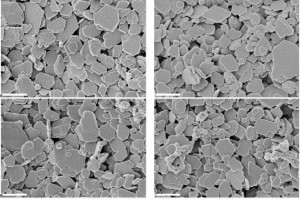An image-based approach was developed by combining microtomography with electron microscopy and contact angle goniometry to determine the pore-scale distribution of crude oil in plugs after waterflooding and shed light on the molecular-scale mechanisms responsible. The approach was applied to a model rock comprising a pack of quartz sand grains without or with a preapplied lining of kaolinite, imaged prior to and after capillary-driven oil recovery by flooding with a model brine of high or low salinity. The presence of kaolinite increased residual oil and reversed its brine dependence, with high-salinity flooding giving greatest recovery from the clean sand and least recovery from kaolinite-coated sand. These two extremes tended to exhibit the most connected residual oil clusters, while low salinity gave smaller blobs, to the detriment or advantage of oil recovery. Low-salinity flooding in secondary or tertiary recovery mode resulted in comparable oil residuals in kaolinite-coated sand. Surface analysis of the grains and model substrate analogs without or with this coating showed that recovery was correlated to the advancing contact angle. In particular, kaolinite was far more resistant than quartz to wettability alteration by this particular crude oil, resulting in a more water-wet state prone to oil trapping via bypassing and snap-off mechanisms.
Full text available here.




